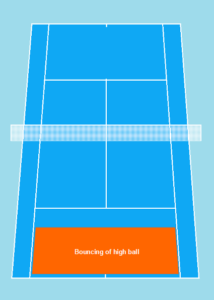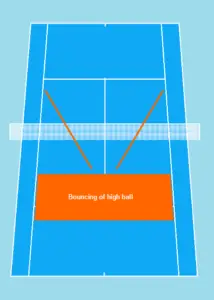Tennis high balls
How to play tennis against high balls?
How to play tennis against high balls?
Your opponent keeps passing the tennis ball high over the net and runs down every ball. She or he just doesn’t make a mistake and you get frustrated and make more and more mistakes. Many tennis beginners have already experienced this situation and grumble about the bringer who plays every ball back as a moon ball. Own hasty mistakes are the consequence and this although the own stroke technique is possibly superior to the opponent.
This does not have to be, because the tennis game against Bringer and the handling of moonshots can be practiced, so that you leave the tennis court as a winner in the end.
Below we explain to tennis beginners what can be done against bringers and moonshots to be victorious.
1. The initial situation against high balls
Your opponent runs and runs and brings each of your balls back to the other side of the tennis net as a high ball, also called a moonshot or moon ball. You have the better stroke technique, but you don’t manage to convert your aggressive balls into point wins and make more and more mistakes.
Your self-confidence in your own tennis strokes dwindles and the rallies become shorter and shorter as you try to win the point too early and too hastily, producing even more errors.
If you find yourself in this situation, it is important to regroup. For example, you can take a short toilet break when changing sides to get your head fresh again. Otherwise you will lose the tennis match a short time later. Of course you don’t want that either and that’s why you think about a tactic against the Bringer or the moon balls.
2. The right hitting point of the ball
First of all, the correct point of impact of the ball is extremely important. By this we mean that you should always hit the tennis ball – whether on the forehand or backhand side – at hip height.
Many tennis beginners do not move well in the high ball situation and hit the ball at shoulder level or even higher.
There are two options for hitting the ball at hip level: you can hit the ball on the rise or on the fall.
a) Hitting the high ball on the rise
Hitting the high tennis ball on the rise is the more aggressive and risky answer. You move early in the direction of the expected rise of the tennis ball and hit the ball directly in the rise.
This variant is more risky because, for example, the tennis ball can bounce differently and you can then only correct your already initiated stroke movement with great difficulty. At the same time, you put your opponent under pressure again, because the ball comes back to him or her faster. The opponent may not yet be back on the bisector, so you may have an advantage.
b) Hitting the high ball on the way down
Hitting the high tennis ball on the way down is the more defensive and less risky answer. You move further back and let the tennis ball fall down again until it reaches your hip height and then hit it.
This option is less risky because, for example, when the tennis ball bounces differently and you still have time to adjust your stroke because the ball is in the air for a long time. On the other hand, you give the opponent time to get back into the ideal position, the angle bisector.
3. The right time to win the point
After you have learned the correct point to hit the high ball, it is time to understand when to use which of the two variations and how.
a) Your opponent plays a high ball to the back of the court.
If your opponent plays a moon ball with good length she or he already has more time to get into the right position.

An aggressive forehand or backhand shot from you would be very risky and would have to be played almost perfectly.
Therefore, in this situation, it is better to hit the tennis ball on the way down and return it safely to the court.
You can, however, surprise your opponent with a high long ball by hitting it directly to the net. Many opponents often only look at the high ball and do not watch you and then often do not notice that you are already at the net. This way you can shorten the point with a volley or a smash and win.
b) Your opponent plays a high ball towards the T-field of the tennis court
If your opponent plays a moon ball with a short length, he or she does not have much time to get into the right position.

Therefore, play an aggressive forehand or backhand on the rise and consciously take the risk. The goal should be to play the ball either placed to the outside, so that the opponent has to run a lot to return the ball. Alternatively, play a slightly faster ball on the opponent’s weak side – often the backhand side for tennis beginners. In both cases you put the opponent under pressure by advancing to the net.
Alternatively, you can play a drop-shot and lure your opponent to the net. Most of the time the opponent is far behind the baseline, so the drop-shot can be a very good alternative. Bringers often feel uncomfortable at the net. You should take advantage of that.
4. Typical mistakes and tips to win against high balls
Finally, three typical mistakes and tips to win against high balls:
a) Change your tennis tactics early on
Many tennis beginners play the game of returning the ball safely for too long. With this tactic they are clearly inferior to the opponent. Keeping your own high balls leads to a guaranteed loss of the tennis match. Therefore, start to change your own tennis tactics in order not to let the opponent’s game develop. Hit the ball at the right height and at the right time and attack the net more often – vary your game.
b) Recognize a weaker side of your opponent’s stroke
For very few tennis players, the forehand and backhand are equally strong. Most of the time one side drops a little. Often it is the backhand side, but it can also be the forehand side. Many tennis beginners assume by default that the backhand side is the weaker hitting side of the opponent. This doesn’t have to be the case, just pay close attention to your opponent’s weaker side and put pressure on it accordingly on short balls to win the point.
c) Put the opponent in awkward positions
The bringer is used to running back and forth on the baseline and returning every ball as a moon balls. She or he is certainly not at the net often because the volley is not mastered the way baseline shots are. Take advantage of this with short balls of your own to lure your opponent to the unfamiliar position at the net. Then you can set up a passing shot to win the point.

